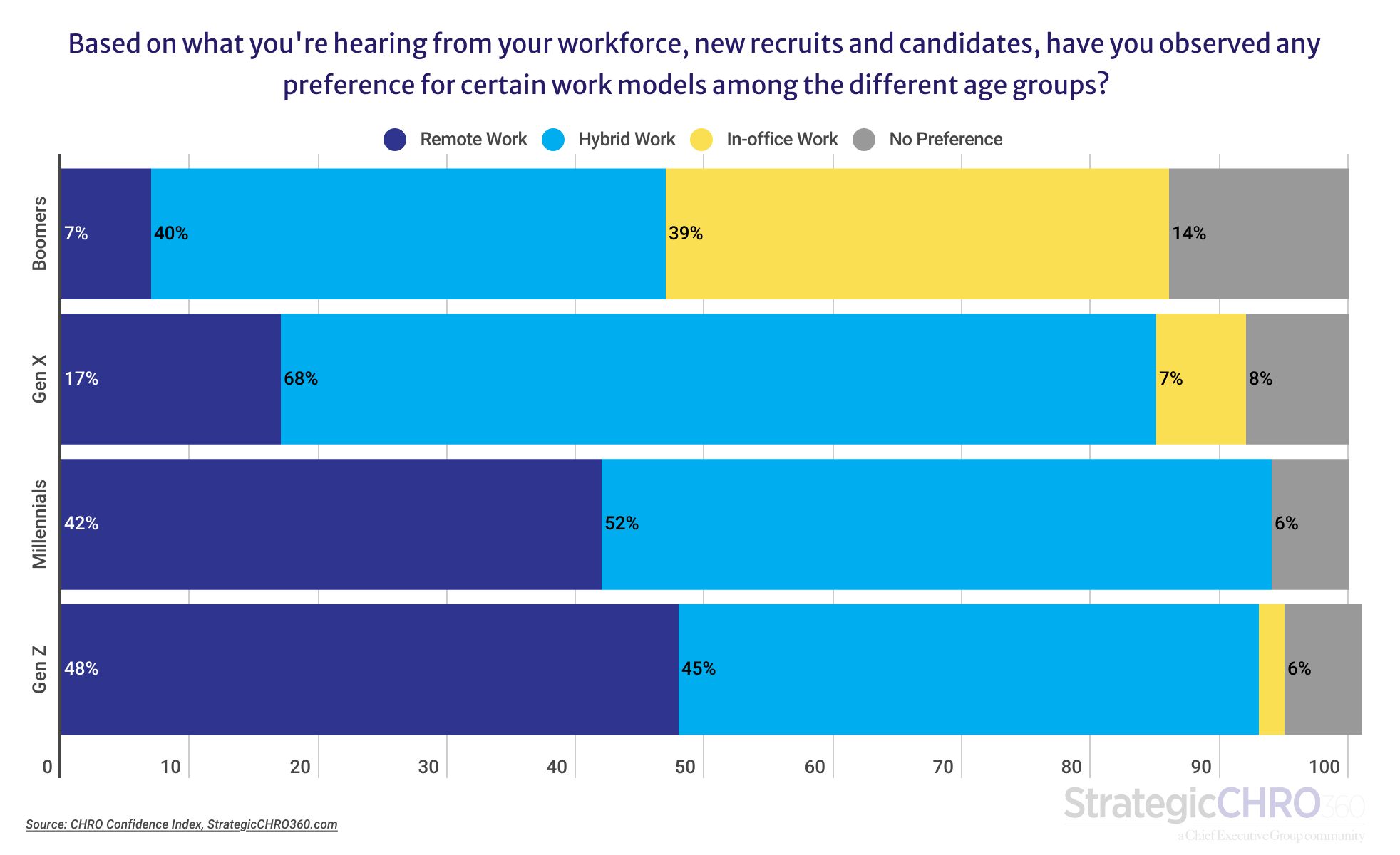A recent survey of CEOs, conducted by sister publication Chief Executive earlier this month, found a growing number of companies reverting to in-office work “by choice.” The problem, the survey found, isn’t so much rooted in declining performance stemming from remote work but rather in the sheer difficulty of managing that workforce.
According to the 121 CHROs we polled April 17-19, making the hasty decision to call workers back into the office or even being too rigid on the hybrid policy can be a costly talent mistake.
When comparing the demand of employees and candidates across different age groups, CHROs say hybrid workplaces are by far most popular: 68 percent say Gen X favors the hybrid model vs. 52 percent for Millennials and 45 percent for Gen Z—who are somewhat split between hybrid and fully remote. Even Boomers, CHROs say, are now finding value in the flexibility of hybrid work.
But CHROs admit that so far into the hybrid experience, the pros and cons are a mixed bag. Only 28 percent of those who have a “hybrid model with a mix of fully remote and fully on-site employees” said they are “very satisfied” with how things are going, vs. 38 percent of those with a “hybrid with pre-determined days on site for all employees” model who said the same.
The big jump in satisfaction is in the level of flexibility provided, the survey found. Of those CHROs with a “hybrid model that provides flexibility as to if/when employees come on site,” 59 percent said they were “very satisfied” with employees’ performance—a much higher proportion than the other two hybrid models. (Too few CHROs reported a fully remote or fully on-site by choice model to be statistically significant as a comparison in this situation.)
“Employees actually work longer hours using this model,” said Laura Evans, CHRO at Oasis Systems, who says performance has increased as a result of the flexibility.
“Increase in productivity by 20%; Turnover decrease of 10%,” echoed the CHRO of an upper middle-market tech company.
Still, despite all the accolades for the flexible hybrid model, it’s worth noting that it’s also the only one that garnered “very dissatisfied” responses (7 percent). Digging into CHRO sentiment on that question, we find loss of connectivity among colleagues as one of the main challenges in those situations, especially with newer employees and those who may seek out more face-to-face time with their managers—who themselves may not come regularly to the office.
“Some roles, primarily administrative in nature (payables, receivables, payroll, assistants), benefit from the in-person guidance from supervisors and collaboration with team-members to provide highest levels of service,” said Jacqueline Cohen, CHRO at Interstate Waste Services—a company that does employ a hybrid model with flexibility as to if/when employees come on site.
Overall, there are of course positives and negatives for each approach, and CHROs say the key is determining what’s most important to the organization—and its employees.
On one hand, said Mary Horan, CHRO at Merrick & Company, where work is “hybrid with flexibility as to if/when employees come on site,” there is no commute so employees have more time in the workday, there are no office distractions, labor costs are decreasing, retention is at its highest and the organization has access to a wider talent pool—all of which has contributed to increased productivity.
On the other, Horan said, there are lost opportunities for mentoring and coaching, the human connection is missing, there is a greater risk of isolation, leaders cannot observe work and behaviors, and that increased productivity reported earlier can also lead to higher burnout risk.
Companies must weigh the pros and cons of each approach, but in this labor market, “the ability to attract and retain staff does seem to be influenced on being competitive with offering hybrid and flexible work options,” said Susanne Pawliuk, CHRO at Tetra Tech.
Wendy Mullen, CHRO at First Manhattan, says even when trying to find a fair compromise with a hybrid model, some employees are simply not having it. “People need to be chased to come in,” she said. “HR has become the attendance police, which is no fun. Bad behavior is starting (i.e., people coming in to ‘check the box’ and leaving early).”
To address these challenges and help CEOs make hybrid and remote work work, we will be hosting two events in the coming days:
- Making Hybrid Work Great, in collaboration with Steelcase, will showcase emerging best practices for hybrid work in a unique in-person day of learning for CEOs, CHROs, CFOs and CIOs contending with new workplace strategies, implications of evolving employee expectations and competition for talent. Speakers include Stephen M.R. Covey, bestselling author, Trust & Inspire and The Speed of Trust; Lynne Borthwick, global talent leader, Thrasio; April Hicks, head of global talent acquisition and people strategy & enablement, Bank of America; and many others. Join us online on April 27.
- The Remote Work Future: A virtual conference that will bring together leaders of remote work organizations and thought leaders to share best practices on fostering innovation and collaboration, effective goal setting and individual coaching that gets results when your employees aren’t in one building and identifying solutions to common cultural challenges. Join us online on May 2.
About the CHRO Confidence Index
The CHRO Confidence Index is a pulse survey of U.S.-based CHROs and HR executives at organizations of all types and sizes on their perspective of the economy and how policies and current events are affecting their companies and strategies. Every quarter, StrategicCHRO360 asks participating CHROs about their top issues and challenges for the months ahead. The results are published on StrategicCHRO360.com and a report is distributed to participants.








